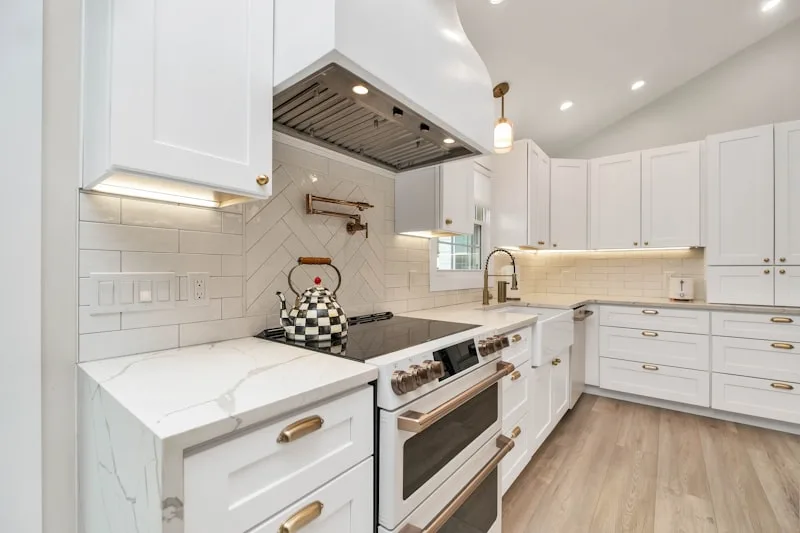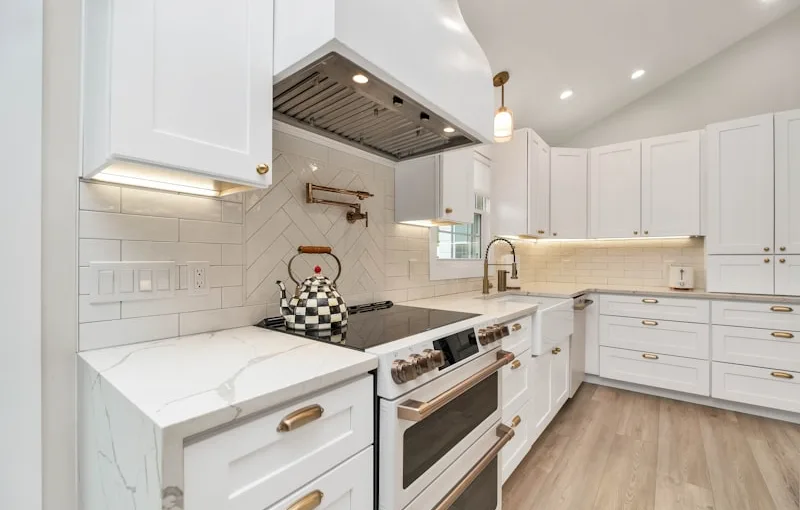The general rule of thumb is to leave about 42 to 48 inches of space between your kitchen island and the surrounding cabinets. Think of it as giving your kitchen room to breathe. This space allows for easy movement, whether you’re whipping up a gourmet meal or just grabbing a snack. If you’ve got a busy household, you’ll want that extra wiggle room to avoid bumping into family members or pets darting around.
Now, if you’re a fan of multitasking, you might want to consider a bit more space—up to 54 inches. This extra width can be a game-changer, especially if you envision multiple cooks in the kitchen or if you’re often entertaining guests. Picture it: you’re chopping veggies on the island while someone else is stirring a pot on the stove, and there’s enough room for everyone to move around without stepping on each other’s toes.
Finding the Perfect Fit: The Ideal Space Between Your Kitchen Island and Cabinets
So, what’s the magic number? Generally, a distance of 42 to 48 inches is recommended. This space allows for easy movement, whether you’re whipping up a gourmet meal or just grabbing a snack. Think of it as the sweet spot where functionality meets style. If you’re cooking with a partner, this distance ensures you won’t be bumping elbows while trying to sauté those veggies.
But let’s not forget about the size of your kitchen. In a smaller space, you might need to adjust that distance a bit. A cozy kitchen can still be efficient with a tighter gap of around 36 inches. It’s like a well-choreographed dance; you can still move gracefully, even in a smaller area.
Now, consider the height of your island too. If it’s taller than your cabinets, you might want to create a bit more space to avoid a cramped feel. Picture a tall building overshadowing a quaint cottage; it just doesn’t vibe well.
And don’t overlook the appliances! If you have a fridge or oven nearby, ensure there’s enough room for the doors to swing open without hitting anything. It’s all about creating a harmonious environment where everything flows seamlessly. So, as you plan your kitchen layout, remember: the right space can transform your cooking experience from chaotic to choreographed.
Kitchen Design 101: How Much Room Do You Really Need Between Your Island and Cabinets?
Typically, you’ll want to leave at least 42 inches of space between your island and the cabinets. This gives you enough room to open cabinet doors, pull out drawers, and, of course, navigate around with ease. Think of it like giving your kitchen a personal bubble—nobody likes feeling cramped, right? If you have a busy household or love to entertain, you might even want to stretch that space to 48 inches. This extra room allows multiple chefs to work their magic without bumping into each other, making your kitchen the ultimate gathering spot.
But what if your kitchen is on the smaller side? Don’t fret! You can still create a functional space. In tighter kitchens, you might get away with 36 inches, but be prepared for a bit of a squeeze. It’s like trying to fit a square peg in a round hole—possible, but not always comfortable.
Also, consider the layout of your kitchen. If your island has seating, you’ll want to ensure there’s enough space for people to pull out chairs and sit down without feeling like they’re in a game of Tetris.
So, as you plan your kitchen design, remember: space is key. It’s all about creating a flow that feels natural and inviting, allowing everyone to enjoy the heart of the home without feeling like they’re in a crowded subway car.
Maximizing Functionality: The Essential Guide to Kitchen Island and Cabinet Spacing
So, how do you find that sweet spot? First off, think about the work triangle: your sink, stove, and refrigerator should form a triangle that allows for easy movement. Ideally, you want at least 42 inches between your island and cabinets. This gives you enough room to open cabinet doors without feeling like you’re in a game of Twister. Plus, it allows multiple cooks to work side by side without stepping on each other’s toes.

Now, let’s talk about the island itself. It’s not just a pretty face; it’s a multifunctional powerhouse! Whether you’re prepping meals, enjoying breakfast, or hosting friends, your island should be designed for versatility. Consider adding seating on one side to create a cozy nook for casual dining. Just make sure there’s enough legroom—about 24 inches per seat is a good rule of thumb.
And don’t forget about storage! Incorporating cabinets or shelves into your island can help keep your kitchen clutter-free. Think of it as a treasure chest for your pots, pans, and gadgets. The more organized your space, the more enjoyable your cooking experience will be.
So, as you plan your kitchen layout, remember that spacing isn’t just about aesthetics; it’s about creating a functional space that flows seamlessly. With the right measurements and thoughtful design, your kitchen can become the heart of your home, where every meal is a celebration.
Is Your Kitchen Cramped? Discover the Optimal Distance Between Islands and Cabinets
Imagine trying to dance in a tiny room—awkward, right? The same goes for your kitchen. Ideally, you want at least 42 inches between your island and cabinets. This space allows for smooth movement, whether you’re whipping up a gourmet meal or just grabbing a snack. Think of it as your kitchen’s personal dance floor, where everyone can twirl around without bumping into each other.
But wait, there’s more! If you have multiple cooks in the kitchen, you might want to stretch that distance to 48 inches. It’s like giving each chef their own stage to perform on. No more stepping on toes or juggling pots and pans in a cramped space.
Now, if your kitchen is on the smaller side, you might be tempted to squeeze things in. But trust me, cramming everything together can lead to chaos. Picture a traffic jam during rush hour—frustrating, right? Keeping that distance not only enhances functionality but also makes your kitchen feel more inviting.
So, before you start rearranging your kitchen, take a moment to measure that space. A little planning can transform your cooking area from cramped to cozy. After all, a well-designed kitchen is like a well-tuned instrument; it plays beautifully when everything is in harmony.
Frequently Asked Questions
What Are the Consequences of Insufficient Space Around a Kitchen Island?
Insufficient space around a kitchen island can lead to safety hazards, restricted movement, and difficulty in accessing appliances and storage. It may cause congestion during meal preparation and hinder the flow of traffic in the kitchen, making it less functional and enjoyable.
What is the Ideal Space Between a Kitchen Island and Cabinets?
The ideal space between a kitchen island and cabinets is typically 42 to 48 inches. This distance allows for comfortable movement and access to appliances while ensuring that multiple people can work in the kitchen without feeling cramped.
Can I Reduce the Space Between My Kitchen Island and Cabinets?
Adjusting the space between your kitchen island and cabinets can enhance functionality and aesthetics. To reduce the gap, consider repositioning the island if possible, or modifying cabinet layouts. Ensure that any changes maintain adequate clearance for movement and access to appliances.
How Much Clearance Do I Need Around My Kitchen Island?
To ensure functionality and ease of movement, maintain a clearance of at least 42 to 48 inches around your kitchen island. This space allows for comfortable passage, especially when multiple people are using the kitchen simultaneously.
What Factors Affect the Space Between Kitchen Island and Cabinets?
The space between a kitchen island and cabinets is influenced by several factors, including the size of the kitchen, the layout, the intended use of the island, and the flow of traffic. Adequate clearance is essential for ease of movement and functionality, typically ranging from 36 to 48 inches. Consideration of appliance doors, cabinet handles, and personal preferences also plays a crucial role in determining the optimal distance.
